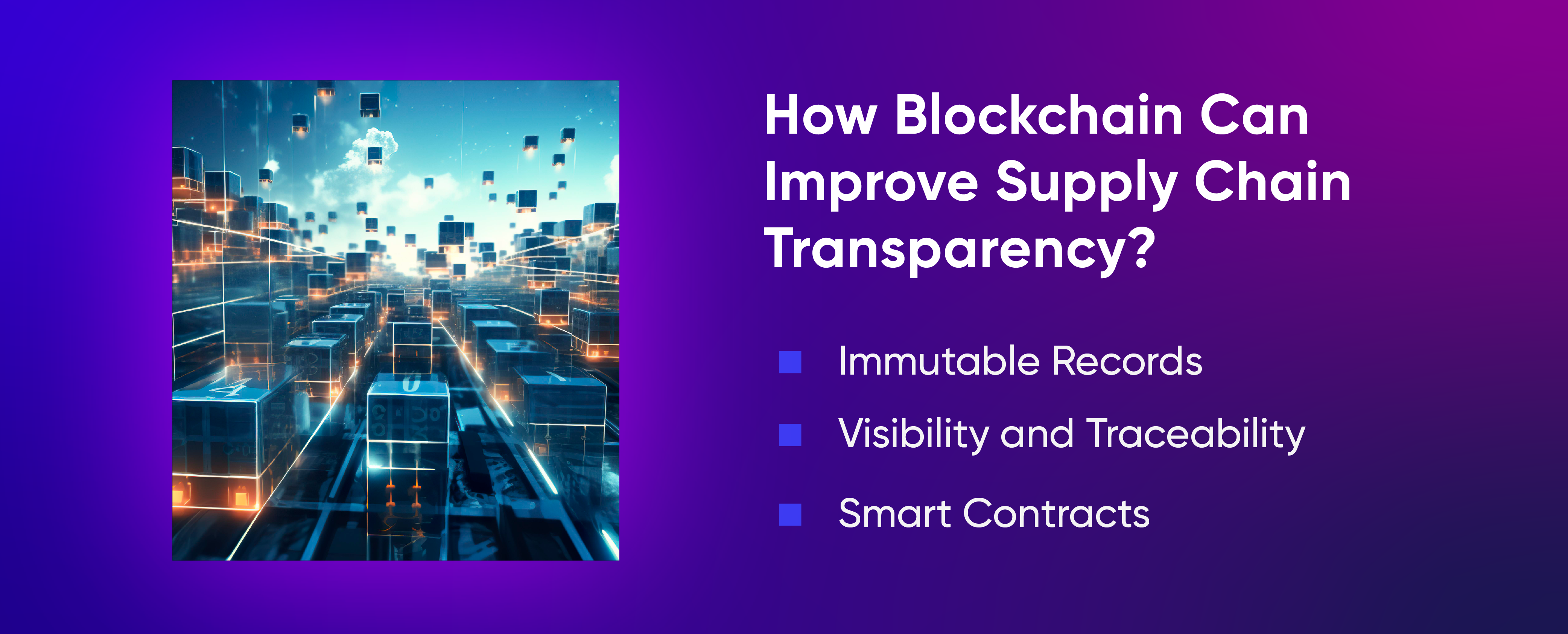
Introduction
Web3 & Blockchain Consultancy :
The Role of Blockchain in Building Transparent Supply Chains
Blockchain technology is rapidly becoming a remarkable innovation in the digital domain, changing the practices of traditional businesses. Blockchain, in simple words, is a secure, unalterable ledger, accessible only with the permission of its originator. This feature ensures high security and transparency while keeping all stakeholders continuously updated about any changes within a specific blockchain. Supply chain management, known for its intricate structure and multi-layered operations involving numerous stakeholders, stands to benefit significantly from blockchain technology. These stakeholders often grapple with challenges related to security, transparency, and traceability. A lack of clear visibility can disrupt operations and complicate order fulfillment processes.Key Takeaways
- What is Blockchain? A secure, decentralized ledger that records transactions immutably across multiple computers.
- Blockchain in Supply Chain: Blockchain solutions enhance tracking and transparency, reducing inefficiencies and improving security in supply chain management.
- Supply Chain Transparency: Allows all stakeholders to access vital information, improving oversight and accountability.
- The benefit of Supply Chain Transparency: Builds trust, reduces costs, and enhances operational efficiency and customer satisfaction.
Understanding Blockchain Technology
Blockchain is a distributed ledger technology that maintains records on multiple computers in a way that ensures security and transparency. The key features of blockchain include decentralization, immutability, and consensus-driven verification, which make it resistant to fraud and tampering. In blockchain, transactions are recorded in blocks linked together in a chain. Each block contains a cryptographic hash of the previous block, a timestamp, and transaction data, making it extremely secure. Network participants, or miners, use computers to validate and record transactions into these blocks. Blockchains are categorized into public, private, and consortium types. Public blockchains are open and anonymous, private blockchains restrict the access to a certain group, and consortium blockchains are governed by a group of organizations. Each type serves different needs in supply chain applications, with private and consortium blockchains being more popular due to their privacy controls.Challenges in Traditional Supply Chains
Exploring the main problems that make today’s supply chains less efficient and transparent.Complexity in Supply Chains
Modern supply chains are intricate networks involving a vast array of stakeholders, such as manufacturers, distributors, retailers, and even end consumers. The sheer number of participants and the global nature of many supply chains add significant complexity and opacity to the process. Each participant has their own systems, processes, and requirements, making coordination and data sharing difficult. The lack of a unified system can lead to miscommunication, inconsistencies in data, and an overall lack of streamlined workflow, complicating every step from production to product delivery.Issues of Transparency
This inherent complexity significantly obscures transparency in traditional supply chains. For instance, without clear visibility, it’s challenging to trace where delays or errors occur or to verify the authenticity and quality of products through the chain. This opacity can lead to several problems, including inefficiencies like misplaced or mislabeled items, delayed shipments, and increased susceptibility to tampering and fraud. Moreover, without the ability to monitor processes effectively, the risk of compliance violations grows, potentially leading to legal issues and financial penalties.Impact of Inefficiencies
The repercussions of these inefficiencies are broad and far-reaching. Firstly, they often result in increased operational costs, as companies may need to spend more on rectifying errors, managing recalls, or paying for expedited shipping to meet deadlines. These additional costs can erode profit margins and make the supply chain less competitive. Secondly, customer satisfaction can plummet if products are delayed, incorrect, or of poor quality. In today’s market, consumers have high expectations for product availability and delivery speed, and failing to meet these expectations can lead to a loss of customer loyalty and negative reviews, which can be devastating in a digital-first world. Moreover, inefficiencies can drastically reduce trust among supply chain stakeholders. If distributors, retailers, and other partners cannot rely on the information or products they receive, relationships can deteriorate, leading to a lack of collaboration and innovation. Over time, this breakdown in trust can lead to a rigid, inefficient supply chain that struggles to adapt to changes in market conditions or consumer demands.How Blockchain Can Improve Supply Chain Transparency?
Let’s explore how blockchain technology enhances transparency in supply chain processes.
Immutable Records
Blockchain technology is celebrated for its immutability, meaning once data is recorded on the blockchain, it cannot be altered or deleted without the consensus of the network. This attribute is crucial in supply chains where the authenticity of record-keeping is often questioned due to potential fraud or error. By using blockchain, companies can ensure that every piece of information – from the origin of raw materials to the manufacturing process and delivery details – is permanently recorded and easily verifiable. This significantly reduces the chances of fraud and unauthorized manipulation, thereby enhancing security across the entire supply chain.Visibility and Traceability
Blockchain enhances visibility and traceability in supply chains by maintaining a clear, unalterable record of every transaction and movement of goods. Each transaction is timestamped and linked to previous transactions, creating a chronological chain of events that can be viewed in real time. This level of detail provides stakeholders with the ability to track products back to their origins, verify compliance with regulatory requirements, and ensure that quality standards are met throughout the lifecycle of the product. For consumers, this means greater confidence in the products they purchase, knowing they can verify claims made by manufacturers and sellers.Smart Contracts
Smart contracts are self-executing contracts with the terms of the agreement directly written into code. In the context of supply chains, smart contracts can automate various processes that traditionally require manual intervention, such as payments, approvals, and quality checks. For instance, a smart contract could be programmed to release payment to a supplier only once a delivery has been verified by a receiving company, or it could automatically trigger an order to a supplier when stock levels fall below a predetermined threshold. This automation not only speeds up operations but also reduces the risk of disputes and errors, as the contract executes automatically based on agreed-upon and verifiable conditions.How supply chain transparency can help the planet?
Blockchain technology also plays a crucial role in promoting environmental sustainability and ethical sourcing. By providing transparent records of how products are made and where materials come from, blockchain can help companies enforce and verify compliance with environmental standards and labor laws. Consumers increasingly demand ethical practices from their brands, and blockchain provides a way to substantiate those claims with undeniable proof.Benefits of Supply Chain Transparency
With supply chain transparency and traceability, businesses can have:- Increased Efficiency and Reduced Costs: Blockchain automates many supply chain processes, reducing the need for manual intervention and thus lowering operational costs.
- Enhanced Security: The secure nature of blockchain helps significantly reduce the risk of fraud and unauthorized tampering.
- Consumer Trust: Transparency leads to greater consumer trust, as customers have access to information about the origins and handling of products.